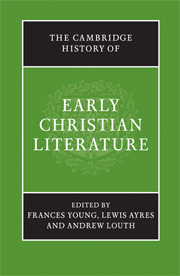Book contents
- Frontmatter
- PART ONE The Beginnings: The New Testament to Irenaeus
- PART TWO THE THIRD CENTURY
- PART THREE FOUNDATION OF A NEW CULTURE: FROM DIOCLETIAN TO CYRIL
- A LITERARY GUIDE
- 21 Classical genres in Christian guise; Christian genres in classical guise
- 22 Arnobius and Lactantius
- 23 Eusebius and the birth of church history
- 24 The fourth-century Alexandrians: Athanasius and Didymus
- 25 Palestine: Cyril of Jerusalem and Epiphanius
- 26 The Cappadocians
- 27 Fourth-century Latin writers: Hilary, Victorinus, Ambrosiaster, Ambrose
- 28 Jerome and Rufinus
- 29 Augustine
- 30 John Chrysostom and the Antiochene School to Theodoret of Cyrrhus
- 31 Cyril of Alexandria
- 32 Hagiography
- 33 Ephrem and the Syriac Tradition
- 34 The literature of the monastic movement
- 35 Women and words: texts by and about women
- 36 Conciliar records and canons
- B CONTEXT AND INTERPRETATION
- Bibliographies
- Index
- Map: The Roman Empire in the late fourth century AD"
- References
25 - Palestine: Cyril of Jerusalem and Epiphanius
from A - LITERARY GUIDE
Published online by Cambridge University Press: 28 March 2008
- Frontmatter
- PART ONE The Beginnings: The New Testament to Irenaeus
- PART TWO THE THIRD CENTURY
- PART THREE FOUNDATION OF A NEW CULTURE: FROM DIOCLETIAN TO CYRIL
- A LITERARY GUIDE
- 21 Classical genres in Christian guise; Christian genres in classical guise
- 22 Arnobius and Lactantius
- 23 Eusebius and the birth of church history
- 24 The fourth-century Alexandrians: Athanasius and Didymus
- 25 Palestine: Cyril of Jerusalem and Epiphanius
- 26 The Cappadocians
- 27 Fourth-century Latin writers: Hilary, Victorinus, Ambrosiaster, Ambrose
- 28 Jerome and Rufinus
- 29 Augustine
- 30 John Chrysostom and the Antiochene School to Theodoret of Cyrrhus
- 31 Cyril of Alexandria
- 32 Hagiography
- 33 Ephrem and the Syriac Tradition
- 34 The literature of the monastic movement
- 35 Women and words: texts by and about women
- 36 Conciliar records and canons
- B CONTEXT AND INTERPRETATION
- Bibliographies
- Index
- Map: The Roman Empire in the late fourth century AD"
- References
Summary
At the Council of Nicaea in 325, the Fathers decreed in their seventh canon that the honour paid to the bishop of Aelia by ‘custom and ancient tradition’ was to be preserved, without prejudice to the rights of the metropolitan city (of Caesarea). ‘Aelia’ (in full: Aelia Capitolina) was the name given to the city established on the site of ancient Jerusalem in 135 after that city had been razed to the ground by the Romans. The canon witnesses to the tensions focused on the city of Jerusalem, with its Gentile name erasing its Jewish associations, while ‘custom and ancient tradition’ honour it as the site of the central events of the Christian faith: the death and resurrection of the Lord. ‘Custom and ancient tradition’ accomplished a good deal in the years following the Œcumenical Council, enabling the Emperor’s mother Helena, on her pilgrimage to the Holy Land in 326 or 327, to identify many of the sacred sites, as well as discovering the relics of the True Cross. Within a decade of the council, these sites had been adorned by splendid new buildings, raised at imperial expense, not least the complex of buildings on the site embracing Golgotha and the tomb whence Christ had risen, including the Church of the Resurrection (the Anastasis), or the Holy Sepulchre, dedicated on 13 September 335. In this way the tension between secular ‘Aelia’ and religious ‘Jerusalem’ was resolved in the Christian city of Jerusalem, set to become the Holy City of Christendom, the goal of pilgrimage and guardian of the places where God had lived his incarnate life.
- Type
- Chapter
- Information
- The Cambridge History of Early Christian Literature , pp. 283 - 288Publisher: Cambridge University PressPrint publication year: 2004
References
- 1
- Cited by

